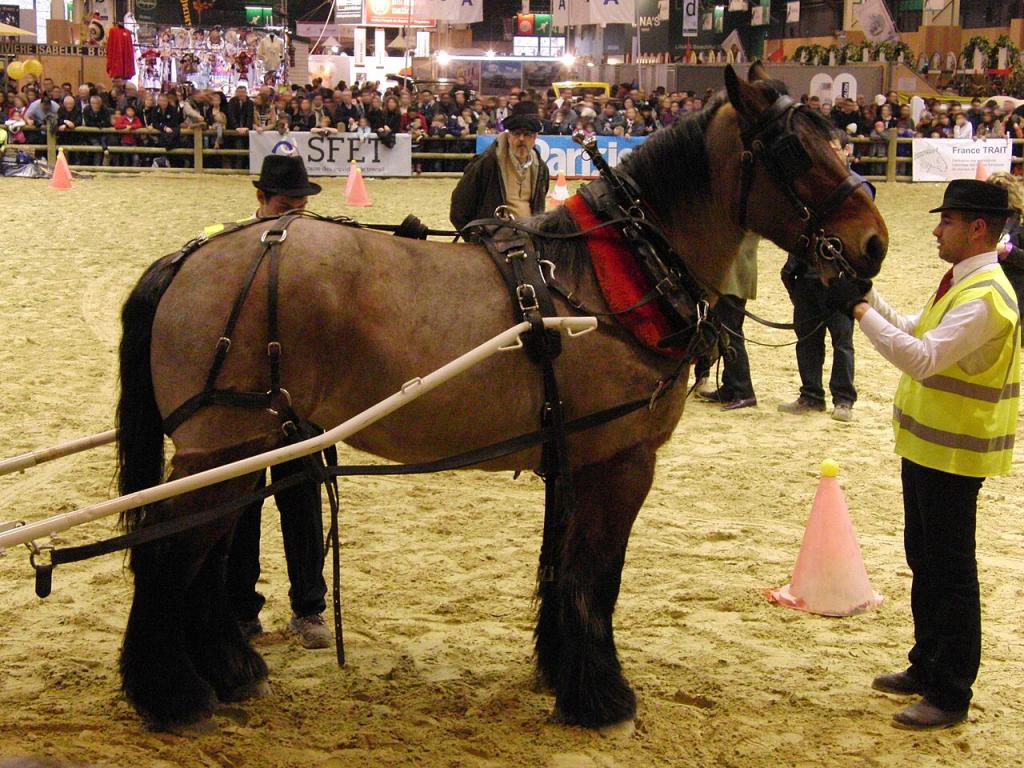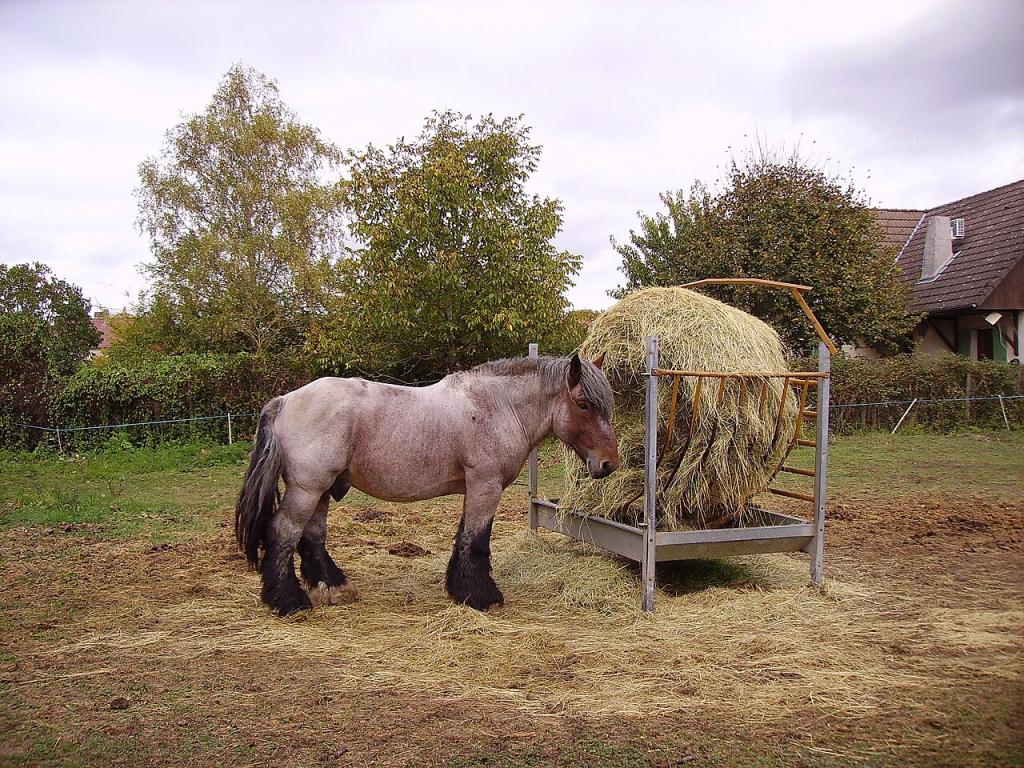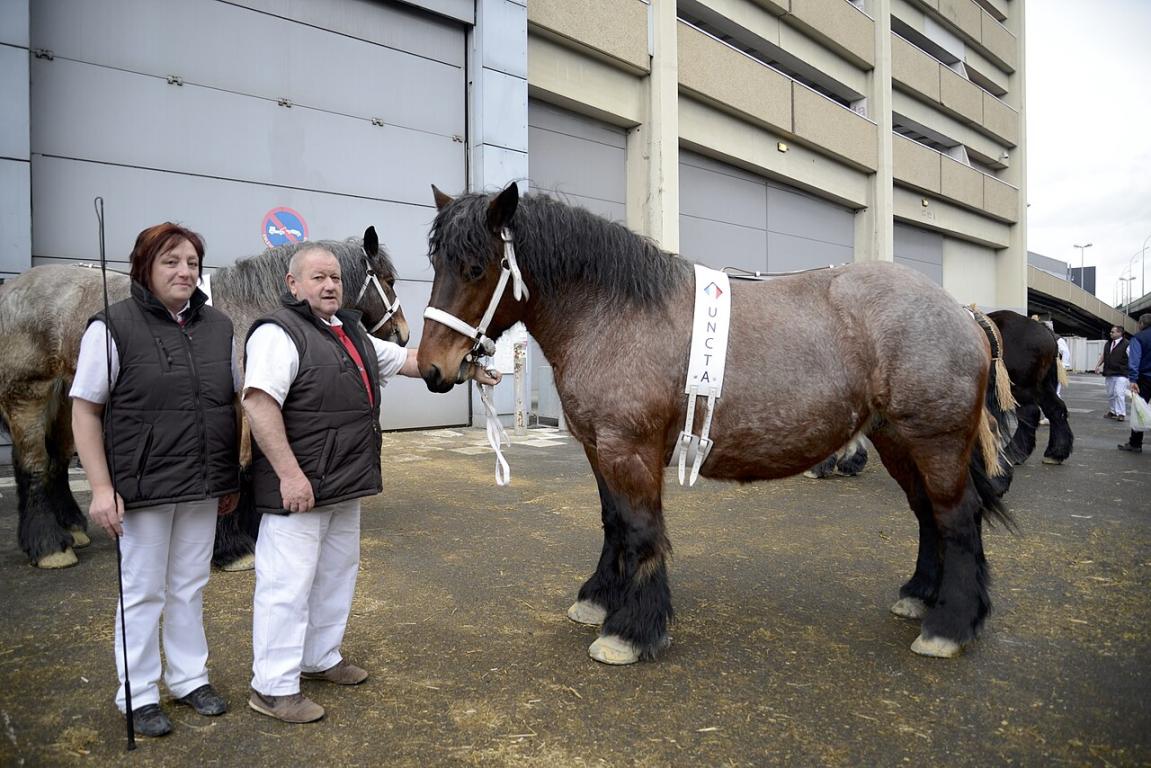
Continent: Europe
Country: France
Weight: 800 – 1100 kg
Height: 165 – 175 cm


The Auxois Draft Horse originates from the natural region of Auxois, located in the heart of Burgundy, in the current Côte-d’Or department (21), France. This area, characterized by rolling hills, preserved hedgerows, and rich pastures, provides an ideal environment for raising strong and rustic horses. The temperate continental climate supports a sustainable form of agriculture historically centered on livestock breeding.
– Region of origin: Burgundy, mainly around Semur-en-Auxois and Saulieu
– Department: Côte-d’Or
– Climate: Temperate continental, favorable to livestock farming
– Landscape: Hedgerow countryside, natural pastures, gentle hills
Cultural Origin :
The Auxois Horse is deeply rooted in Burgundian rural culture. It emerged in the 19th century from the crossbreeding of local mares with heavy draft stallions particularly the Boulonnais, Ardennais, and especially the Trait du Nord — with the goal of producing a powerful, docile, and agriculturally useful horse.
– Traditional use: Agricultural work, heavy traction, deep plowing
– Socio-economic role: A pillar of peasant economy before mechanization
– Regional symbol: Embodies the quiet strength and agricultural know-how of Burgundy
– Contemporary value: Now promoted as a living heritage, especially through ecological traction, leisure activities, and agrotourism
The Auxois region remains the birthplace of the breed, where breeders, local authorities, and enthusiasts work actively to ensure its preservation and its recognition as a strong element of regional identity.
The Auxois Horse is mainly bred in its historic birthplace, the natural region of Auxois, located at the center of the Côte-d’Or department in Burgundy-Franche-Comté. This area remains the geographic heart of the breed and concentrates most of the traditional breeders.
Main breeding areas:
– Côte-d’Or (21): around Semur-en-Auxois, Saulieu, Précy-sous-Thil, Vitteaux, and Montbard, all strongholds of rural tradition
– Nièvre (58): extending westward from Auxois, especially near Corbigny and the Morvan Regional Park
– Yonne (89) and Saône-et-Loire (71): some peripheral farms engaged in conservation breeding or mixed agricultural practices
Regional characteristics :
– Temperate to continental climate, ideal for extensive livestock farming
– Rich pastures and permanent grasslands, promoting slow and robust growth
– Hedgerow landscapes, preserving traditional and respectful farming methods
– Presence of dedicated breeders committed to safeguarding rare breeds
The historic breeding zone is supported by local associations, regional authorities, and agritourism initiatives that actively contribute to the recognition and intergenerational transmission of the breed.
The Auxois Draft Horse holds a significant genetic heritage value, both as the heir of a specific regional lineage and as a guardian of genetic diversity within the group of French draft breeds. Its conservation plays a key role in maintaining domestic equine biodiversity.
Controlled genetic origin :
Developed in the 19th century, the Auxois resulted from crossings between local Burgundy mares and stallions of the Boulonnais, Ardennais, and especially the Trait du Nord breeds. The aim was to create a strong and versatile heavy draft horse. It retains distinctive morphological traits such as a solid bone structure, a short back, and powerful limbs, which clearly set it apart.
Small population size :
Listed among the endangered breeds in France, the Auxois represents a reduced population with a narrow genetic base. Preserving its lineages is essential to ensure genetic diversity among heavy draft horses, which are in overall decline.
Hardiness and adaptability :
Selected for demanding rural environments, the Auxois is known for its excellent pulling power, physical toughness, and natural resilience. These qualities make it highly relevant for selection programs focused on hardiness and sustainable agriculture.
Role in preserving French draft breeds :
As one of the nine officially recognized French draft breeds, the Auxois plays an active role in safeguarding the national zootechnical heritage. It also serves as a complementary genetic reservoir for other breeds in crossbreeding, diversification, or conservation programs.
The Auxois Draft Horse is the heir to a long-standing agricultural and equestrian tradition from the Auxois region in Burgundy. Its history is part of the broader legacy of great European draft horses, yet it has developed a distinct identity, shaped by local needs and the characteristics of its native land.
Ancient origins (before the 19th century) :
The Auxois countryside, rich in pastures, had long produced saddle and work horses known for their hardiness. These horses were used for light draft work, military service, and agriculture.
As early as the Middle Ages, historical records mention horses bred in this region, often referred to as “Burgundian type”, and used in the ducal and royal armies.
Creation of a specific breed (19th – early 20th century) :
With the Industrial Revolution and the growth of modern agriculture, the need for heavy draft horses became essential.
From around 1860–1880, breeders in the Auxois began crossing local mares with stallions of heavy breeds mainly Boulonnais, Ardennais, and especially Trait du Nord to produce a larger and more powerful horse.
This selection program led to the development of a local type well-suited to deep plowing, hauling heavy loads, and working on the hilly terrain of the region.
Official recognition (1912) :
In 1912, the Stud-book of the Auxois Draft Horse was officially created, marking the administrative recognition of the breed.
The breed standard was based on the Trait du Nord, but adapted to the morphological traits and climatic conditions of the Auxois region.
Peak and decline (1920–1970) :
Between the World Wars and throughout the 1950s, the Auxois Horse experienced its golden age, widely used in farms, transport, and even by the military.
However, starting in the 1950s–1960s, the mechanization of agriculture led to a dramatic decline in demand for draft horses.
The breed was then redirected toward meat production, leading to a shift in the standard toward even heavier and bulkier animals.
Preservation and revival (since the 1980s) :
Faced with a sharp decline in births, local breeders and the French Ministry of Agriculture launched conservation programs.
The National Union for the Auxois Draft Horse was established to coordinate selection, promotion, and preservation efforts.
Since the 1990s, the focus has shifted to non-meat uses such as vineyard work, driving, logging, urban traction, and rural tourism.
Today
The Auxois Horse is officially listed as an endangered breed, but its population has remained relatively stable thanks to local valorization efforts and regular breed shows (notably in Semur-en-Auxois).
It is now regarded as a living heritage of Burgundy a symbol of calm strength, rural roots, and territorial identity.
The Auxois Draft Horse is known for its calm, docile, and cooperative temperament, making it an excellent working horse. It is particularly well-suited for human interaction, even in modern settings such as urban traction or tourism-related activities.
- Natural docility : The Auxois horse has a gentle nature and is easy to handle, even by inexperienced individuals. This makes it ideal for harness driving or animal-assisted therapy.
- Willingness to cooperate: It generally shows a strong work ethic, follows commands reliably, and easily develops consistent working habits.
- Cold-blooded temperament : Like most draft breeds, it is not easily startled, which makes it very safe in noisy or unfamiliar environments (fairs, urban settings, vineyards).
Work attitude :
– Enduring and steady, capable of maintaining effort in challenging conditions
– Easily adapts to various types of traction work: agricultural, forestry, vineyard, or urban
It demonstrates a certain situational intelligence, allowing it to navigate obstacles or follow a driving route with some autonomy.
Relationship with humans :
The Auxois is very people-oriented, forming strong bonds with its handler or driver, especially in calm and routine environments.
It is also appreciated for its patience, making it suitable for animal therapy, ethological education, or as a beginner-friendly horse for leisure driving.
Behavior at a young age :
Foals are typically curious and not very fearful. Their early education is made easier by their flexible character, making them easy to handle from weaning.
In summary, the Auxois Horse combines strength, patience, calmness, and affection for humans, making it an ideal partner for both work and leisure, in rural or semi-urban contexts. Its reliability and reassuring nature are central to its success in modern ecological and cultural roles.
The Auxois Horse remains one of the nine recognized French draft breeds, but is also among the three most endangered, due to its limited population size. Since the late 1990s, the population has stabilized, with an average of 100 to 120 births per year since 2016–2018. Most breeding still takes place in Burgundy-Franche-Comté, with some additional centers in Auvergne, Rhône-Alpes, Charente, and more recently around Bordeaux.
New uses and promotion :
Originally bred for agricultural traction and later for meat production, the Auxois has seen a renewed purpose in recent decades across diverse fields:
– Vineyard work, introduced as early as 1997 in Burgundy (notably at prestigious estates like Romanée-Conti)
– Forest logging in natural and protected environments
– Urban traction and eco-friendly landscape maintenance
– Mare’s milk production
– Leisure driving and public events
These uses help reposition the breed in meaningful and sustainable sectors.
Conservation and selection :
Breeding is strictly controlled through authorized crossings with Ardennais and Trait du Nord stallions, recognized as Auxois factors, to ensure breed typicity and limit inbreeding risks.
The breed is managed by the National Union for the Auxois Draft Horse, established in 2014, which oversees:
– Stud-book management
– Breed standard definition
– Annual shows, especially in Semur-en-Auxois
Challenges and issues :
Despite stable birth rates, the breed remains vulnerable, exposed to:
– Genetic fragility (small population, narrow base)
– Dependence on public subsidies
– A potential decline in breeders if no structured projects or long-term incentives are maintained
Opportunities and future prospects :
The growing use of the Auxois in organic viticulture, eco-traction, and rural tourism offers promising prospects.
Emerging applications in animal-assisted therapy, environmental education, and eco-services may generate new demand, particularly from:
– Local governments
– Wine estates
– Rural or environmental associationsA modest start to exportation (notably to Charente and beyond Burgundy) also suggests a potential for geographic expansion, provided the breed’s strengths are properly promoted.
The Auxois Draft Horse is recognized for its natural robustness, a trait inherited from its farming origins and adaptation to demanding agricultural environments. Its overall health is solid, provided its basic needs especially those related to its size and draft physiology are properly respected.
Health strengths :
– Hardiness: The Auxois tolerates varied weather conditions well, including the cold and damp winters typical of Burgundy
– Stable digestive system: When well-fed and kept in appropriate stable or pasture conditions, it is rarely affected by serious digestive issues (e.g., colic, laminitis)
– Low stress: Its calm disposition limits the development of nervous or stress-related behaviors, often linked to secondary health issues
Genetics and inbreeding :
The stud-book authorities actively monitor and limit inbreeding risks, as the population remains small.
No major hereditary disorders have been reported at the breed level so far, but close monitoring of bloodlines is essential to preserve genetic diversity.